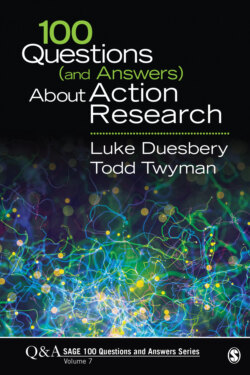Читать книгу 100 Questions (and Answers) About Action Research - Luke Duesbery - Страница 16
На сайте Литреса книга снята с продажи.
ОглавлениеQuestion 7 How Is Action Research Cyclical?
It begins, and it never ends. This is true with action research, and with learning in general. Think about it. When you get smarter about something, you are naturally led to new questions, new curiosities, and then more answers. Let us illustrate what an Action Research Cycle (ARC) looks like.
Description
Figure 1.1
The ARC begins as you identify a problem and shape it into a question or hypothesis statement. Most often, it is a question of whether or not some innovation works, and upon what it might depend. For example, perhaps you notice a problem at work. In this identification stage the action researcher would probably seek advice from others, or perhaps Google the problem to see what others are doing about it. Identifying the problem, and thus your research question and hypothesis, is the first stage in the ARC.
Most often, the next step is to gather data. In some cases, your question will already be based on sound data, and gathering more is unnecessary. In schools, many teachers will use student outcome data, like quizzes, tests, or grades. Some might choose observable behaviors like attendance, referrals, and so on. Still others may choose to create a survey or questionnaire to gather data. Health care workers will use patient well-being inventories. Entrepreneurs will likely be concerned with employee and customer satisfaction and, ultimately, profit. The question identified often dictates the kind of data you will use. For example, perhaps a teacher recognizes students are not doing their homework. Then the question identified might be
Will checking homework as students enter class improve the homework completion rate?
For this example, the data collected are determined by the research question. The need now is to determine how often students do their homework. The action plan is a written procedure of what, when, and how you will do something. This is an important step because it forces you to think through contingencies before you implement a plan. In this step, you operationalize your thinking and make it concrete.
When you implement the plan, you are taking note of anything out of the ordinary that happens that might unduly influence the result.
Either during or after the action, you will again gather data. In the homework example, you were gathering data throughout the action. In other situations, you may find yourself having to collect data after some intervention or change.
Now that you have your data, you will need to analyze them. This is where you turn data into usable information. Data alone do not help decision making. Did it work for everyone? Are there some groups it did not work for? As you compile the information and reflect on the results you are naturally led to deeper questions. You are led back to the beginning to reshape your thoughts now that you’ve learned something.
While not an absolutely necessary component of the cycle, we recommend action researchers also take the time to report results. This might be as simple as sharing with a colleague or as ambitious as publishing the research in a professional journal.
More questions? See 6 and 8.
Descriptions of Images and Figures
Back to Figure
The cyclic figure shows the following steps in sequence:
Identify a Problem
Gather Data
Make an Action Plan
Implement the Plan
Gather Data
Analyze Data
Evaluate the Action
Report Results
After the last step, the cycle starts again.
